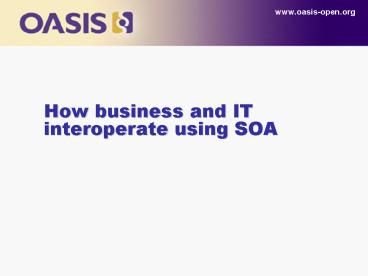How business and IT interoperate using SOA - PowerPoint PPT Presentation
Title:
How business and IT interoperate using SOA
Description:
www.oasis-open.org How business and IT interoperate using SOA Speakers Mark Pettit. Head of Integration and Product Services Steve Jones. CTO Application Development ... – PowerPoint PPT presentation
Number of Views:137
Avg rating:3.0/5.0
Title: How business and IT interoperate using SOA
1
How business and IT interoperate using SOA
www.oasis-open.org
2
Speakers
www.oasis-open.org
- Mark Pettit. Head of Integration and Product
Services - Steve Jones. CTO Application Development
Transformation
3
Contents
- The interoperability challenge
- The three tenets of interoperability
- Method
- Delivery
- Organisation
- Summary
- QA
4
- The interoperability challenge
5
Is Business and IT divided or united by SOA?
- Do we have a shared understanding of business
problems? - Do we have a shared understanding of business
opportunities? - Do we collaborate to find solutions and act in
unison to deliver?
6
The interoperability chasm
Entrenched IT
Business Fear
Projects
Cost
Products
Value
Organisation
Standards
S and A
7
Who is the Babelfish?
- Too often Business and IT speak different
languages - Both sides continually argue that the other is
wrong and they are right - IT estates rarely look like the business
- Business rarely looks to the long term impacts of
IT
8
Traditional Organisation Business Aligned
BU
BU
BU
BU
IT (AD)
IT (AD)
IT (AD)
IT (AD)
Program Office
Central IT (mainly infrastructure)
9
Traditional Organisation Capability
BU
BU
BU
BU
Program Office
Central IT
IT Project
IT Project
IT Project
IT Project
10
- The three tenets of interoperability
11
The three tenets of interoperability
Method
Delivery
Organisation
12
- Method
13
Our take on the SOA hype
- SOA is not WS
- SOA is not about BPEL
- SOA is not about ESB
- SOA is not about Technology
- Not driven by the How
HOW
Service-oriented Architecture works because it
represents a real-world what we do.
14
Use the SOA Reference Model
- Not vendor driven
- Applies to business as well as IT
- Defines what good looks like
- Doesn't tell you how to do it
A service is a mechanism to enable access to a
set of one or more capabilities provided by one
entity the service provider for use by
others.
15
Engage the business to determine the what, who
and why
- What Defining the scope of services, this is
about determining what the services actually are. - Who Who are the external actors that drive the
services or with which the services interact. - Why Identifying why one service talks to
another, and why external actors interact with
the services - How The detail about the processes that
co-ordinate the services and also the detail on
how a service itself will be implemented.
16
Structure matters
- Clearly defined structure
- Defined areas of shared ownership
- Driven by how the company works
- Do it once, well
- Aligned to the business goals
- Driven by how the business wants to react
- Think about Process second
- NOT THE SAME AS ORG CHARTS
- Millions of Services
- Disjoint from how the company works
- Lack of clear ownership
- Duplication
- Missed opportunities
- Unclear strategy
- Driven by techies using Web Services
17
Rules for establishing an Enterprise SOA
- Work with the business to understand the key
business services and their drivers - Create the Enterprise SOA first then aim to
deliver it tactically - Ensure that tactical projects leave the company
better off - Deliver the Business Services
- Refine the Enterprise SOA
- Penalise the projects that make it worse
18
- Delivery
19
A business-driven SOA drives the delivery approach
- Sourcing Strategy
- Delivery Model
- Business Transformation
- Delivery Transformation
20
Delivering SOA
Business
IT
Architectural Governance
Business SOA
Programme
Programme SOA
21
Drive down from the top
- Projects and enterprises should define their
Service Architecture FIRST - Requirements and process need to be in the
context of that architecture - Architecture needs to be defined so all
stakeholders understand - Needs to be an collaborative exercise
- Once you have the service, THEN think about
process
22
- Organisation
23
Can Enterprise Architecture build the bridge?
Business
IT
Enterprise Architecture
Interface
Context
Strategy
Common Language
Governance
Tools
Techniques
24
Governance of a new IT Asset
- Business services are a new IT asset that require
a new governance model - Not predicated on ownership
- Some form of centralisation
- Funding and resource planning
- Change management
- Standards - e.g. for business semantics and
processes
25
Organisation for SOA
EA
BU
BU
BU
BU
IT (AD)
IT (AD)
IT (AD)
IT (AD)
Funding and Governance
Central IT (AD, Governance, SOI)
26
- Summary
27
Summary
- To deliver the true value of SOA and become a
service-oriented enterprise, we must recognise
the importance of interoperability by - Investing in an enterprise SOA developed by both
the Business and IT - Ensuring delivery processes accommodate SOA
approach - Structuring the organisation to ensure successful
delivery and ongoing management of assets
28
- Questions?































